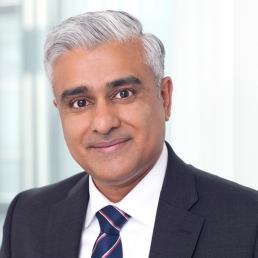Mental health and COVID-19: a clinician's perspective
The global COVID-19 pandemic has highlighted new and existing challenges around mental health care. One in four adults experience mental illness, (NHS England) and many more of us know and care for people who do. For many, the COVID-19 pandemic has created anxiety which is a normal response to uncertainty (WHO, 2020).
In his latest conversation, Chetan Trivedi discuss the impact of coronavirus on mental health with Dr Tarun Gupta, a General Practitioner and Occupational Health Physician based in the UK.
The impact of coronavirus on mental health
In our first video interview we explored the impact of COVID-19 on mental health. Dr. Gupta shared examples of what he is witnessing on the ground.
The impact of technology on mental health
In our second short video we discuss the impact of technology in healthcare generally, how technology plays a role in supporting patients with mental health conditions, and some of the limitations of technology.
Prevention, assessment and treatment
In our final segment, Dr. Gupta answers the question… if he was appointed Mental Health Tsar, how would he address mental health care in the UK?
Useful resources
- World Health Organisation mental health guidance
- NHS Mental Health and Wellbeing homepage
Contact us for more information or submit a request for proposal to our healthcare consulting team
The convergence of healthcare and travel
Airports and the wider transportation industry are facing a number of new challenges as they prepare for the realities of a post COVID-19 world.
Aviation and mass transit are dependent on density, the antithesis of social distancing. John Holland-Kaye, CEO, Heathrow Airport recently stated “It’s just physically impossible to socially distance with any volume of passengers in an airport.” He continued “The constraint is not about how many people you can fit on a plane; it will be how many people you can get through an airport safely”.
To address these constraints, many airports are considering how to adapt their existing operating models for the new reality and adhere to any new health and safety regulations.
What could the future of airports look like?
Already many airports, including those based in the UK, have introduced measures to enable essential travel based on government guidelines. Those guidelines include social distancing, ample distribution of hand sanitiser throughout airports and efforts to spread passengers evenly across terminals.
However, such measures may not be as easily implemented when capacity is ramped up towards pre COVID- 19 levels and therefore innovative and creative methods will be needed to help increase passenger confidence and change the narrative. Passenger confidence will be the key driver to getting back to some level of normality!
Accelerated automation across the customer journey
The passenger journey is changing. Post COVID-19, passengers may welcome the acceleration of automation across commercial aviation and urban mobility in order to limit physical contact.
A new era of automation is likely to extend from the basic such as the eradication of all remaining doors requiring pushing or pulling to the more advanced. These might include gesture or eye-movement-based interactions with payment kiosks and in-flight entertainment screens; robots and drones equipped with UV lights that continuously sanitize surfaces; and artificial intelligences that govern our previously clumsy attempts at everything from bus scheduling and curb usage to security screening and aircraft boarding.
We spoke with one passenger experience company, Elenium Automation, who are trialling ‘touchless travel’ technology. Etihad Airways recently announced that it plans to partner with Elenium Automation to trial new technology which allows self-service devices at airports. The technology will be used to help identify passengers with medical conditions, potentially including the early stages of COVID-19. Watch our interview with Elenium Automation here.
The new customer journey requires process optimisation and staff upskilling to ensure new regulations are complied with and the spread of viruses are mitigated.
The convergence of healthcare and aviation
Airports in Asia are one step ahead, having learnt from their experience dealing with SARS. For example, the Airport Authority Hong Kong are in the process of rolling out new measures that include the following:
- Full body disinfection channels
- Antimicrobial coatings
- Autonomous cleaning robots working 24/7
Bournemouth Airport are currently trialling thermal cameras in order to detect if passengers have fevers or other indications of disease. Airline passengers would simply walk through a series of tunnels, gardens, or other environments designed around new biometric-enabled security screening methodologies—without ever touching anything or even producing passports or other documents.
Identification through temperature monitoring then is likely to funnel through to more rigorous and accurate healthcare assessment. Technology is simply the enabler. This flow through process needs to be designed, procured for and integrated into the overall operating model, which will require retraining of airport employees, third-party contracting staff, process and system changes.
Service based offering
Less footfall simply means less custom, just as it does on any high street. In addition to less footfall, customers may be less willing to browse, and there may be capacity constraints in entering retail spaces.
How will customers spend their time at airports? We may see a shift from retail to service-based airport offerings. We may start to see GP (physician) kiosks or pharmacies set up within airports to provide health check-ups or assessments.
Similarly, first class lounges may start to offer basic health check services, particularly for frequent flyer customers. In addition, this repurposed real estate could serve a highly valuable consumer segment that includes those retired and travelling throughout off-peak hours.
Virus passport integration
The aviation industry may increase health and safety measures through integrating passports or ID documents, “immunity passports” with recent medical records or vaccination history. However, the introduction of such solutions will likely open up the debate of civil liberties and data security.
The identification and rapid diagnosis of COVID-19 symptoms is key to limit the spread of the virus and implement next-steps such as track-and-trace, self-isolation or early warnings to the receiving/host country. There is evidence now emerging in the US and China, based on small studies, that a large percentage of the population may be asymptomatic. If true, then airports will also have to put in place measures to monitor passengers who might be asymptomatic (i.e. showing no symptoms, but may still carry an infectious virus).
Future direction of travel
As evident above, there are a number of complex nuances to any airport COVID-19 response. Ultimately, the response must strike the correct balance between ramping up capacity so passengers can begin to book fares and reassuring passengers that it’s safe to be on a plane and in an airport.
1 Response continuum
- An airport may choose to do the bare minimum. Taking this option, airport management may roll out a minimum cost and effort plan that includes temporary measures with the view to ramping up and down the measures as they see fit while capacity increases or the threat decreases.
- On the other end of the spectrum, an airport may invest heavily in technologies coming to market and seek to robustly implement health and safety guidelines.
Taking the latter option, its salient that management look to strongly embed this move in their infrastructure and operations, processes and technologies so that they look to benefit from the implementation in the long run irrespective of an increasing/decreasing COVID-19 threat. This may include catering for a ‘new norm’ of passengers who expect hygiene and safety measures in place. Availability heuristics refers a mental shortcut that relies on immediate examples that come to a given person’s mind when evaluating a specific concept and it is likely that passenger behaviour and expectations may shift drastically even if a vaccine is found in the near future.
Outside of the confines of the airport, there is also opportunity to look at what assurances could be provided pre-travel. Such measures could minimise the chances of spread from travel and re-write the narrative on airline travel as a conduit of illness spread.
2 Assess readiness
Rapid assessment and implementation of most effective and customer reassuring COVID-19 protection measures. This may include measures such as staff testing, upskilling and scaled approaches/scenario planning to a capacity ramp up. According to the Centre for Disease Control and Prevention in the US, global pandemics have been as strong, if not stronger in wave two. If this is the case, airports have a fiduciary responsibility to their staff, customers and shareholders to have scenario planned the impact of wave two to minimise the impact.
3 Analyse feasibility
Detailed customer journey analysis to identify highest points of risk and feasibility analysis of MedTech offerings to cater for above risks. The solution is likely to be different for inbound versus outbound travel. The question then arises about where the level of responsibility lies. Is it with the government who may own the airport, or with the airlines and/or airports or a combination or all of the above. Scenario planning and insight driven decision making is key to getting these essential business decisions correct.
4 Assess revenue opportunities
Identify and generate a business case for post coronavirus revenue drivers and opportunities such as service offerings. For example, vacant airport real estate could be utilized as a lead generator for a major UK private hospital and/or a retail pharmacy chain and also heighten confidence of consumers remiss to getting back to aviation travel. Health and general well-being are likely to propel up the consumer agenda going forward.
Contact us
We help businesses with strategy and digital transformation, Get in touch to find out how we can help or arrange a free virtual meeting with our Healthcare and Infrastructure partners.
Chetan Trivedi
Healthcare Partner
Nigel Brannan
Infrastructure Partner








